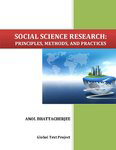
Social Science Research: Principles, Methods, and Practices
This book is designed to introduce doctoral and graduate students to the process of scientific research in the social sciences, business, education, public health, and related disciplines. This book is based on my lecture materials developed over a decade of teaching the doctoral-level class on Research Methods at the University of South Florida. The target audience for this book includes Ph.D. and graduate students, junior researchers, and professors teaching courses on research methods, although senior researchers can also use this book as a handy and compact reference.
The first and most important question potential readers should have about this book is how is it different from other textbooks on the market? Well, there are four key differences. First, unlike other text books, this book is not just about “research methods” (empirical data collection and analysis) but about the entire “research process” from start to end. Research method is only one phase in that research process, and possibly the easiest and most structure done. Most text books cover research methods in depth, but leave out the more challenging, less structured, and probably more important issues such as theorizing and thinking like a researcher, which are often prerequisites of empirical research. In my experience, most doctoral students become fairly competent at research methods during their Ph.D. years, but struggle to generate interesting or useful research questions or build scientific theories. To address this deficit, I have devoted entire chapters to topics such as “Thinking Like a Researcher” and “Theories in Scientific Research”, which are essential skills for a junior researcher.
Second, the book is succinct and compact by design. While writing the book, I decided to focus only on essential concepts, and not fill pages with clutter that can divert the students’ attention to less relevant or tangential issues. Most doctoral seminars include a fair complement of readings drawn from the respective discipline. This book is designed to complement those readings by summarizing all important concepts in one compact volume, rather than burden students with a voluminous text on top of their assigned readings.
Third, this book is free in its download version. Not just the current edition but all future editions in perpetuity. The book will also be available in Kindle e-Book, Apple iBook, and on-demand paperback versions at a nominal cost. Many people have asked why I’m giving away something for free when I can make money selling it? Well, not just to stop my students from constantly complaining about the high price of text books, but also because I believe that scientific knowledge should not be constrained by access barriers such as price and availability. Scientific progress can occur only if students and academics around the world have affordable access to the best that science can offer, and this free book is my humble effort to that cause. However, free should not imply “lower quality.” Some of the best things in life such as air, water, and sunlight are free. Many of Google’s resources are free too, and one can well imagine where we would be in today’s Internet age without Google. Some of the most sophisticated software programs available today, like Linux and Apache, are also free, and so is this book.
Fourth, I plan to make local-language versions of this book available in due course of time, and those translated versions will also be free. So far, I have had commitments to translate thus book into Chinese, French, Indonesian, Korean, Portuguese, Spanish versions (which will hopefully be available in 2012), and I’m looking for qualified researchers or professors to translate it into Arabic, German, and other languages where there is sufficient demand for a research text. If you are a prospective translator, please note that there will be no financial gains or royalty for your translation services, because the book must remain free, but I’ll gladly include you as a coauthor on the local-language version.
The book is structured into 16 chapters for a 16-week semester. However, professors or instructors can add, drop, stretch, or condense topics to customize the book to the specific needs of their curriculum. For instance, I don’t cover Chapters 14 and 15 in my own class, because we have dedicated classes on statistics to cover those materials and more. Instead, I spend two weeks on theories (Chapter 3), one week to discussing and conducting reviews for academic journals (not in the book), and one week for a finals exam. Nevertheless, I felt it necessary to include Chapters 14 and 15 for academic programs that may not have a dedicated class on statistical analysis for research. A sample syllabus that I use for my own class in the business Ph.D. program is provided in the appendix.
Lastly, I plan to continually update this book based on emerging trends in scientific research. If there are any new or interesting content that you wish to see in future editions, please drop me a note, and I will try my best to accommodate them. Comments, criticisms, or corrections to any of the existing content will also be gratefully appreciated.

This work is licensed under a Creative Commons Attribution 4.0 International License.
